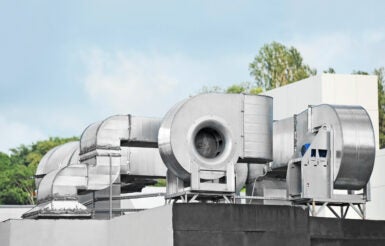Know how the Fan Energy Index helps improve efficiency and savings
Key decision makers such as buyers, building facility operators, and maintenance managers look at multiple factors when considering fans for new builds and retrofit projects. Tangible outcomes such as operational efficiency, energy and cost savings, and equipment reliability all play important roles and affect costs. Here are a few ways fans with a higher Fan Energy Index (FEI) can improve a project’s bottom line:
- Operational efficiency: Typically, the higher the FEI—which is calculated based on specific operating conditions and the combined efficiency of all components in the fan system—the lower the energy consumption of the fan to provide the same performance as baseline fans. This may be especially helpful when fans are in continuous-use applications like large commercial HVAC systems, hospitals, and data centers.
- Energy and cost savings: FEI provides a direct, normalized way to compare the energy performance of fans in design conditions. Lower energy consumption can often be tied directly to a reduction in energy waste, which can affect the overall facility operational costs and long-term expenses. Some selection software created by manufacturers features the operational costs and FEI to show the direct correlation between higher efficiency fans and lower operational costs per year, based on parameters entered by the user. Some higher efficiency fans are integrated with sensors that allow building operators to monitor performance and detect component or system failures early, increasing opportunities to save energy and reduce costs.
Many manufacturers provide selection software that allows users to input data to determine the best fan for a specific project. Using this software, along with an understanding of the FEI metric, can help users understand how a particular fan can reduce maintenance and operation costs—and meet or exceed building code standards—even if efficiency is not a stated project requirement.
Key takeaways: Energy is one of the highest expenses when looking at costs associated with operating a fan, and FEI has a direct tie to cost savings. The higher the rating, the more money can be saved. Some selection software is designed to identify fans that minimize energy costs and best meet the needs of the project. Although fans with a higher FEI may come with a larger price tag, improvements to operational efficiency and reductions to energy consumption may help offset those costs over time.
Additional resources
Read the other parts of the 5 Things You Should Know Before Selecting an Efficient Fan series:



